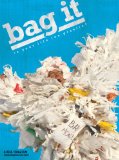| Reviews & Columns |
|
Reviews DVD TV on DVD Blu-ray 4K UHD International DVDs In Theaters Reviews by Studio Video Games Features Collector Series DVDs Easter Egg Database Interviews DVD Talk Radio Feature Articles Columns Anime Talk DVD Savant Horror DVDs The M.O.D. Squad Art House HD Talk Silent DVD
|
DVD Talk Forum |
|
|
| Resources |
|
DVD Price Search Customer Service #'s RCE Info Links |
|
Columns
|
|
|
Bag It
The zippy, appealing documentary Bag It gives new and unsettling meaning to the old TV commercial slogan "Plastics make it possible." With the affable Jeb Berrier as our guide and host, the film delves into what plastics did make possible: toxic gasses, looming environmental catastrophes, and a culture of disposability that accounts for a staggering amount of garbage that simply will never go away. Fun!
Bag It begins with 40-ish everyguy Berrier contemplating the humble plastic bag. Forget "paper or plastic?," the polyethylene bag seems to be the default souvenir of even the smallest shopping trip - whether we asked for it or not. Where did they all come from, and why have they proliferated so much in recent years? Using a battery of experts, Berrier explores how they came to be and the reasons why they won't naturally absorb back into the ecosystem. Across Europe and Asia, logical thinking has resulted in these noxious buggers getting dispensed with extra fees or banned outright. In the U.S., where conspicuous consumption is every American's birthright, organized efforts to reduce plastic bag usage has been more of a struggle. What can one person do?

In case it wasn't completely obvious already, Bag It takes on a similar tact that Michael Moore and Morgan Spurlock use in their films, with it's "average joe" protagonist attempting to come to terms with the big issues of the day. It's a chancy path to take, and Jeb Berrier at first comes across like the kind of self-important dweeb who quotes NPR stories and generally shows off his own superior, crunchy-granola lifestyle. Stay with it, however. Berrier doesn't have the same gravitas as Moore and Spurlock, but his affability and persistent need to get to the truth eventually wins you over. Throughout the film, director Suzan Beraza keeps things easy-going and accessible, with sleek motion graphics and music that seems to have been pilfered from the "twee" section of the local indie record store.
As Berrier deepens his investigation, speaking to a bunch of sustainable-living experts, he finds that the amount of plastic in an average consumer's daily life is much more encompassing that most realize. The take-away coffee cups you get at Starbucks? Lined with plastic. The metal cans of food at the supermarket? Also lined with plastic. Perhaps the most stirring moments in this film come with the statistics flashed onscreen: Americans use 300 million disposable coffee cups a day, while the world consumes a staggering 500 billion bags every year. That last nugget prompts Berrier to visit with communities in Europe who have kicked the plastic bag habit, while his attempts to contact someone at the U.S. lobbying trade organization The American Chemistry Council results in some silly, Roger & Me-esque episodes. Meanwhile, Berrier's exploits take on a more personal tone as he finds that his wife, Anne, is going to have a baby.
The film delves into more eye-opening territory as Berrier explores the world of plastic bottles, along with the facts and myths associated with plastic manufacturing and recycling. Although I always suspected those convenient little bottles of water were a huge waste of resources (to the tune of 17 million barrels of oil a year), this film articulates precisely why in an accessible, breezy manner. But there's always recycling, right? It turns out that plastic recycling is still a work in progress. Many plastic items are not recyclable at all (so much for those arrow logos imprinted on them). Unlike aluminum and glass, the plastic that does get recycled cannot be endlessly reused - one shot is all they've got.
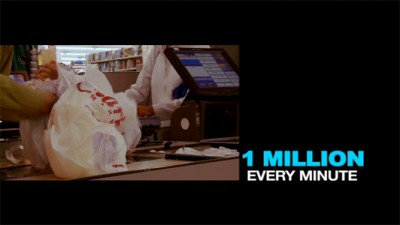
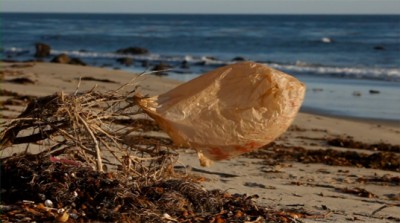
The most heartbreaking segments occur when Berrier looks into the impact our plastic-lovin' lifestyle has on the earth's oceans. This includes a visit to the North Pacific Subtropical Gyre, a.k.a the Great Pacific Garbage Patch. This noxious soup of broken down plastic detritus is a huge hazard to sea life (and there are similar patches in every ocean - whoopee); it outnumbers the natural plankton in the water at a ratio of 6 to 1. Fish and other marine life eat the plastic in record numbers, then the consumed toxins wind up in our food supply. Depressing, yes, but hopefully the film will open some eyes and prompt people to get changes made on a national level.
While Bag It triumphs as a fact-based documentary, the film does delve into less successful areas when Berrier brings his personal life into the proceedings. Near the film's end, as his wife's due date is approaching, Berrier decides to conduct an experiment in which he spends a week immersed in products that use phthalates - a plasticizing agent commonly used in shampoos, lotions, plastic dishes and toys and other things geared towards children and babies. While the segment is funny and informative, it strikes me as too Morgan Spurlock/Super Size Me to be wholly effective. The film also turns rather smug in the end, when the message gently turns to "We need to curb our plastic-dependent lifestyle - because we just had a baby." Yeah, okay.
Despite that shortcoming, Bag It is a stirring, informative film that needs to be seen by anyone who's ever used a plastic bag or takeaway coffee cup - and that is everyone.
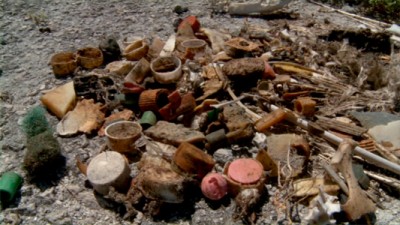
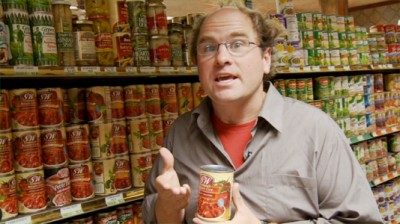
The DVD:
The eco-sensitive themes in Bag It extend to the packaging used in Reel Thing Films' DVD edition of the film. The slipcased eco-pack made from recycled paperboard is a nice enough gesture, but that's not all of it. They've also ditched the plastic in the DVD tray, which is molded from a dense, papery Dutch-made material known as PaperFoam. The disc itself remains the usual plastic/metal (what, you wanted something made of reconstituted corn husks?).
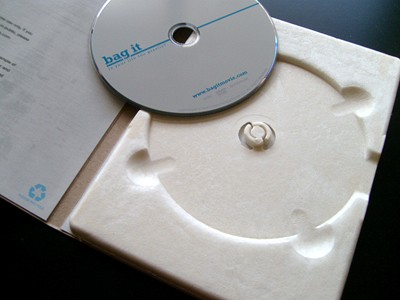
Video:
The mostly digital, 16:9 picture on Bag It is clear and nicely balanced. The filmmakers also use a lot of archival material, which is of varying quality but not terrible enough to sully the viewing experience.
Audio:
The film's English-language stereo soundtrack is the only audio option. It sounded good, with little intrusiveness from the film's occasional music-backed segments. No subtitles are provided.
Extras:
Roughly 11 minutes of bonus footage, mostly of interviewees from the film, make up the disc's sole bonus content. Although one can see why the footage of Jeb marveling at the car-less streets in the Netherlands was deleted from the final cut, it was nonetheless enjoyable.
Final Thoughts:
With Bag It, filmmakers Jeb Berrier and Suzan Beraza explore the ramifications of our never-ending plastic consumption with results that are funny, enlightening and sometimes touching. They also fall into the trap of dealing with the subject in a smug, stereotypically smarty-pants manner, but there's enough sobering information presented to make this a solidly recommended film.
Matt Hinrichs is a designer, artist, film critic and jack-of-all-trades in Phoenix, Arizona. Since 2000, he has been blogging at Scrubbles.net. 4 Color Cowboy is his repository of Western-kitsch imagery, while other films he's experienced are logged at Letterboxd. He also welcomes friends on Twitter @4colorcowboy.
|
| Popular Reviews |
| Sponsored Links |
|
|
| Sponsored Links |
|
|
| Release List | Reviews | Shop | Newsletter | Forum | DVD Giveaways | Blu-Ray | Advertise |
|
Copyright 2024 DVDTalk.com All Rights Reserved. Legal Info, Privacy Policy, Terms of Use,
Manage Preferences,
Your Privacy Choices | |||||||









